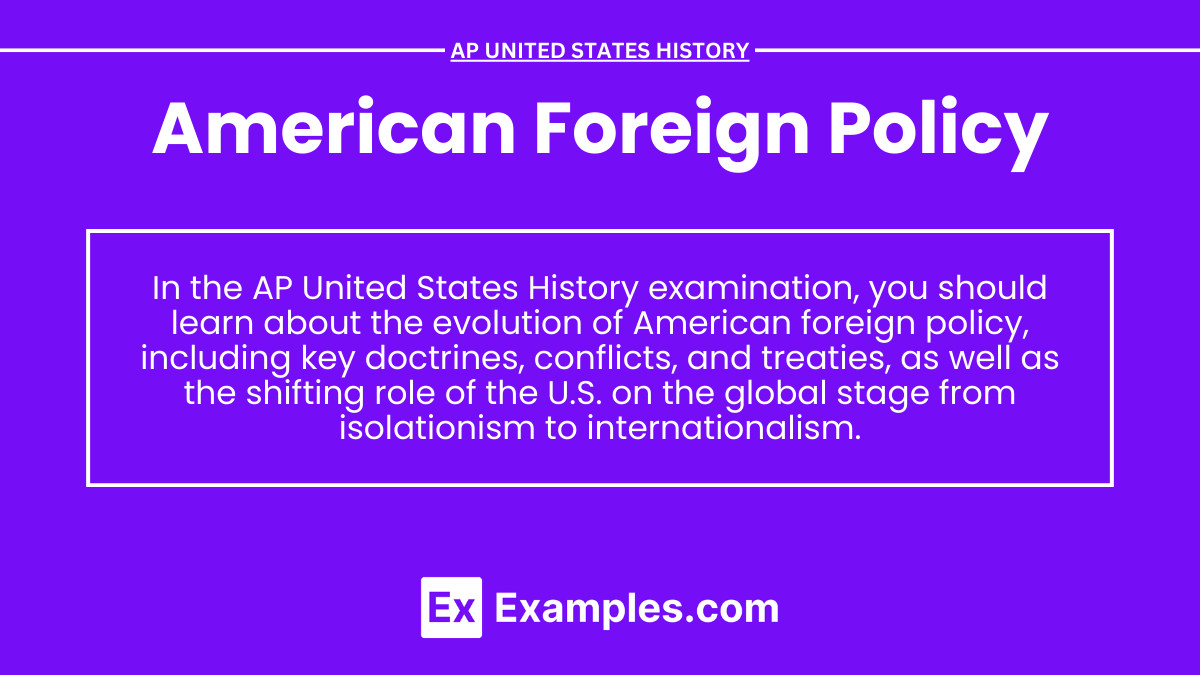In AP United States History, American foreign policy is a critical theme that reflects the nation’s evolving role on the global stage. From its early emphasis on neutrality and isolationism, as seen in Washington’s Farewell Address and the Monroe Doctrine, to its later engagement in global conflicts and the promotion of democracy during the Cold War, U.S. foreign policy has been shaped by a complex interplay of ideological, economic, and strategic interests. This topic highlights the significant decisions and doctrines that have defined America’s interactions with the world.
Learning Objectives
In studying American foreign policy for AP United States History, you will be expected to analyze the evolution of U.S. foreign policy from isolationism to internationalism. The significance of key doctrines, treaties, and conflicts that shaped America’s role in global affairs will be examined. You will also be able to evaluate how foreign policy decisions impacted both domestic and international outcomes, and how shifts in policy reflected broader economic, political, and ideological changes within the United States.
Foundations of American Foreign Policy (18th Century)
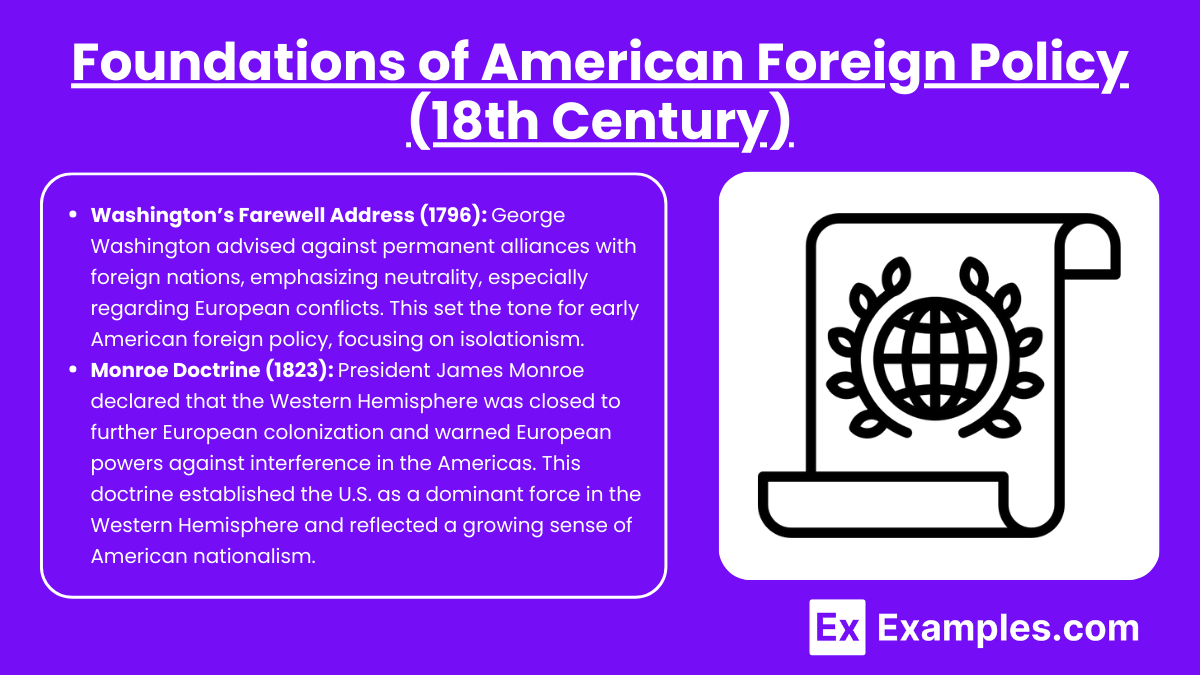
- Washington’s Farewell Address (1796): George Washington advised against permanent alliances with foreign nations, emphasizing neutrality, especially regarding European conflicts. This set the tone for early American foreign policy, focusing on isolationism.
- Monroe Doctrine (1823): President James Monroe declared that the Western Hemisphere was closed to further European colonization and warned European powers against interference in the Americas. This doctrine established the U.S. as a dominant force in the Western Hemisphere and reflected a growing sense of American nationalism.
19th Century Expansionism
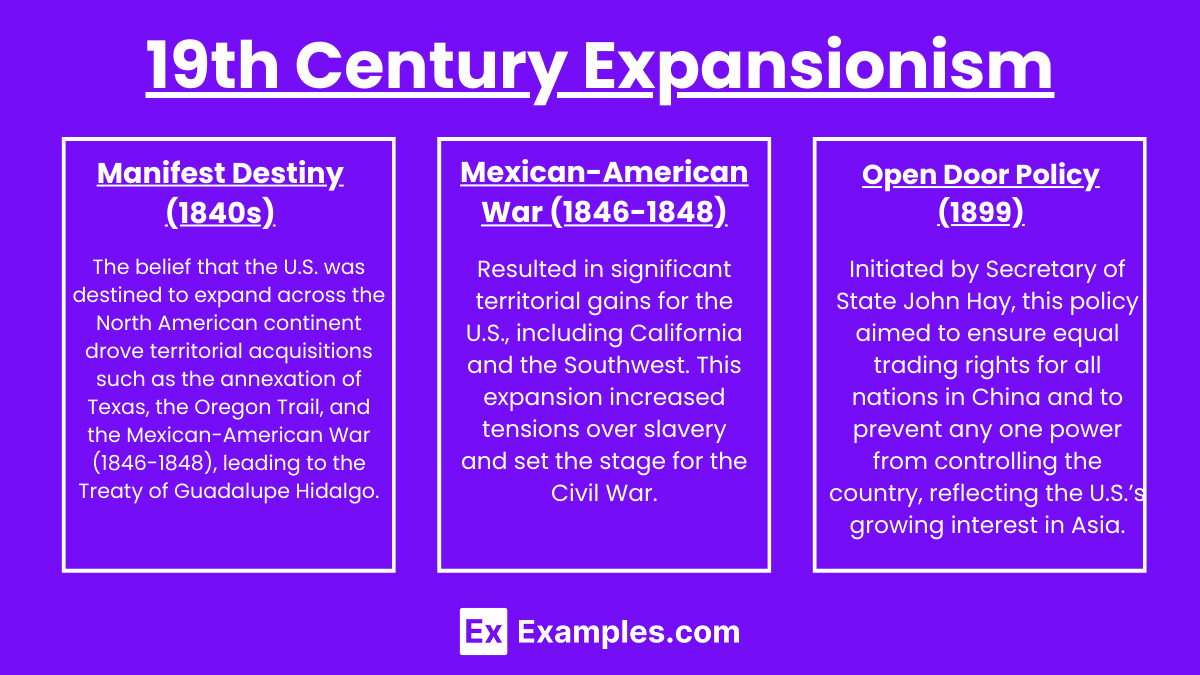
- Manifest Destiny (1840s): The belief that the U.S. was destined to expand across the North American continent drove territorial acquisitions such as the annexation of Texas, the Oregon Trail, and the Mexican-American War (1846-1848), leading to the Treaty of Guadalupe Hidalgo.
- Mexican-American War (1846-1848): Resulted in significant territorial gains for the U.S., including California and the Southwest. This expansion increased tensions over slavery and set the stage for the Civil War.
- Open Door Policy (1899): Initiated by Secretary of State John Hay, this policy aimed to ensure equal trading rights for all nations in China and to prevent any one power from controlling the country, reflecting the U.S.’s growing interest in Asia.
Early 20th Century
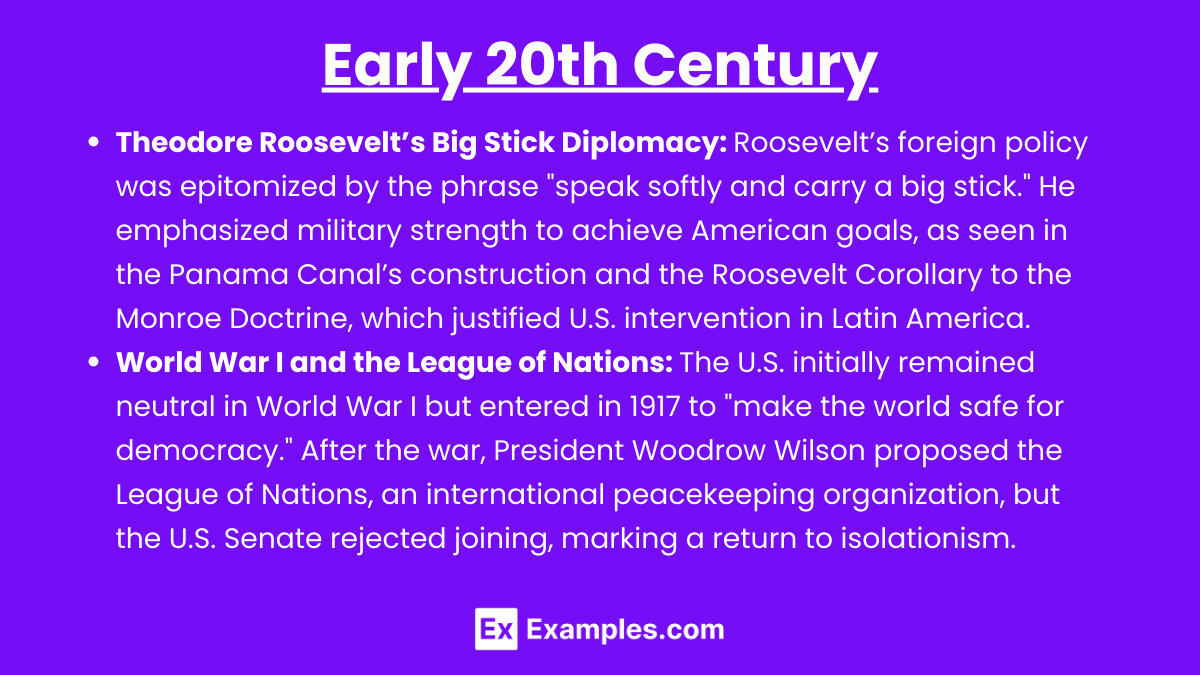
- Theodore Roosevelt’s Big Stick Diplomacy: Roosevelt’s foreign policy was epitomized by the phrase “speak softly and carry a big stick.” He emphasized military strength to achieve American goals, as seen in the Panama Canal’s construction and the Roosevelt Corollary to the Monroe Doctrine, which justified U.S. intervention in Latin America.
- World War I and the League of Nations: The U.S. initially remained neutral in World War I but entered in 1917 to “make the world safe for democracy.” After the war, President Woodrow Wilson proposed the League of Nations, an international peacekeeping organization, but the U.S. Senate rejected joining, marking a return to isolationism.
Mid-20th Century
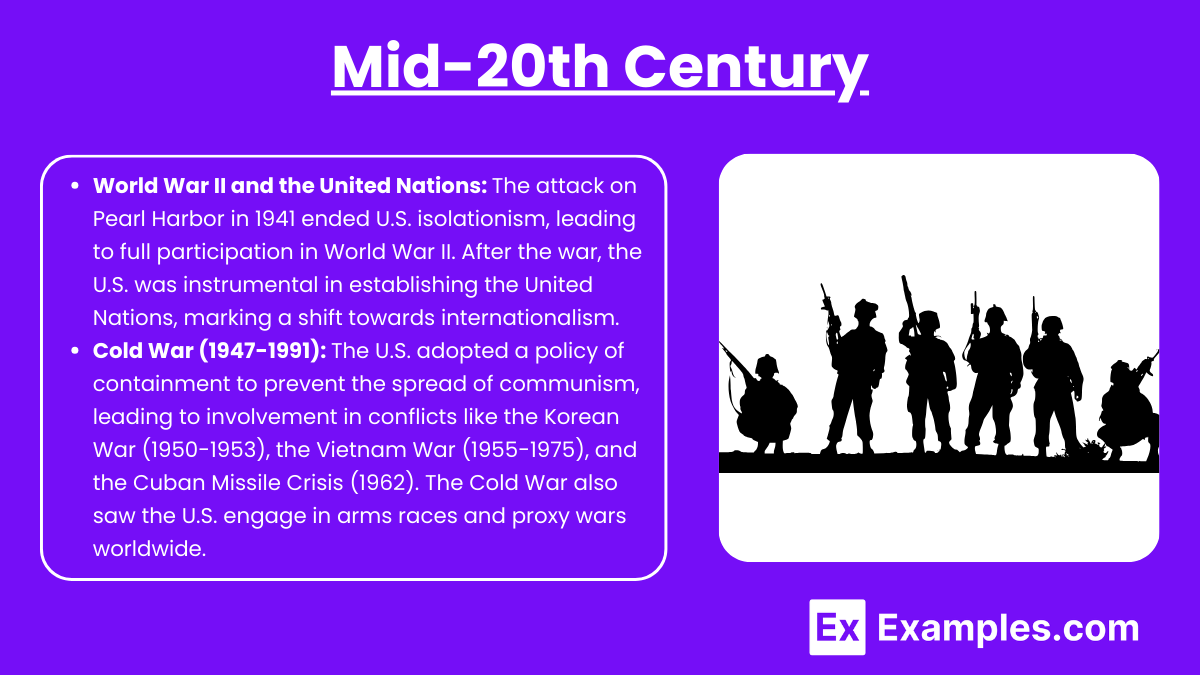
- World War II and the United Nations: The attack on Pearl Harbor in 1941 ended U.S. isolationism, leading to full participation in World War II. After the war, the U.S. was instrumental in establishing the United Nations, marking a shift towards internationalism.
- Cold War (1947-1991): The U.S. adopted a policy of containment to prevent the spread of communism, leading to involvement in conflicts like the Korean War (1950-1953), the Vietnam War (1955-1975), and the Cuban Missile Crisis (1962). The Cold War also saw the U.S. engage in arms races and proxy wars worldwide.
Late 20th and Early 21st Centuries
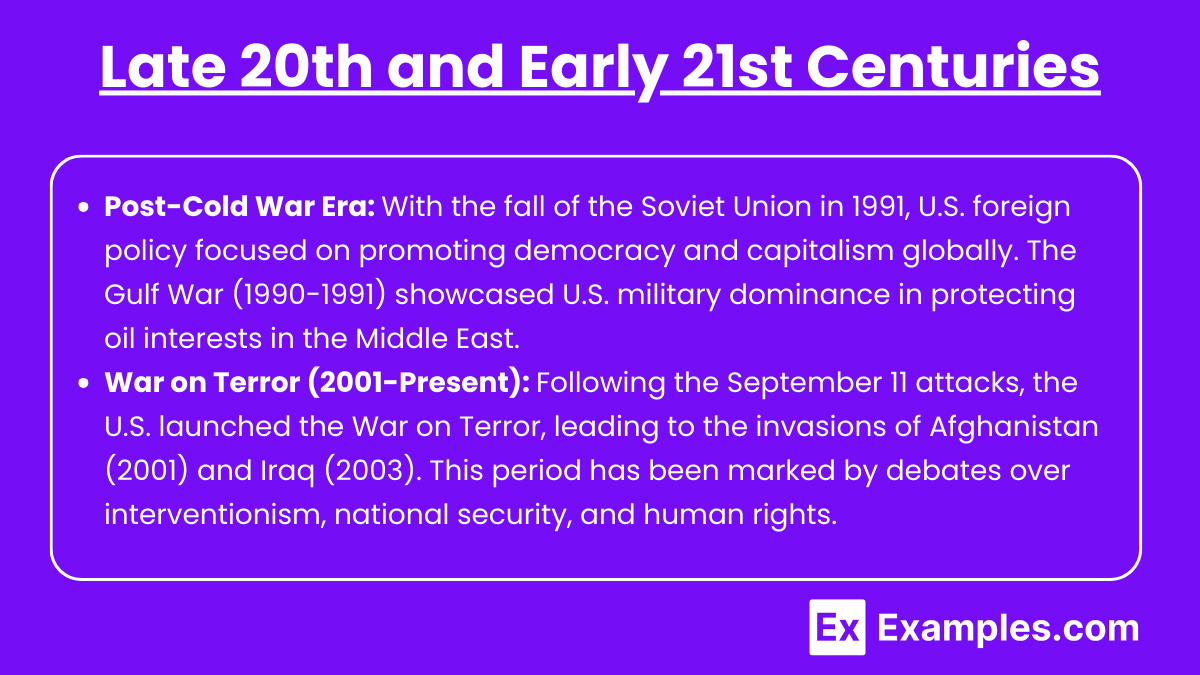
- Post-Cold War Era: With the fall of the Soviet Union in 1991, U.S. foreign policy focused on promoting democracy and capitalism globally. The Gulf War (1990-1991) showcased U.S. military dominance in protecting oil interests in the Middle East.
- War on Terror (2001-Present): Following the September 11 attacks, the U.S. launched the War on Terror, leading to the invasions of Afghanistan (2001) and Iraq (2003). This period has been marked by debates over interventionism, national security, and human rights.
Examples
- Monroe Doctrine (1823): Asserted U.S. influence in the Western Hemisphere and warned European powers against further colonization.
- Roosevelt Corollary (1904): Expanded the Monroe Doctrine by asserting the U.S.’s right to intervene in Latin American countries to stabilize their economies.
- Marshall Plan (1948): Provided economic aid to rebuild European nations after World War II, aiming to prevent the spread of communism.
- Truman Doctrine (1947): Pledged U.S. support for countries resisting communism, leading to American involvement in Greece and Turkey.
- NATO (1949): Established the North Atlantic Treaty Organization as a military alliance to counter Soviet influence in Europe.
Multiple-Choice Questions (MCQs)
1. The primary purpose of the Monroe Doctrine was to:
- A. Promote trade with European nations
- B. Expand U.S. territory into Latin America
- C. Prevent European interference in the Americas
- D. Establish the U.S. as a global superpower
Answer: C. Prevent European interference in the Americas
Explanation: The Monroe Doctrine aimed to limit European influence in the Western Hemisphere, asserting U.S. dominance in the region.
2. Which U.S. foreign policy was characterized by the phrase “speak softly and carry a big stick”?
- A. Truman Doctrine
- B. Big Stick Diplomacy
- C. Dollar Diplomacy
- D. Containment Policy
Answer: B. Big Stick Diplomacy
Explanation: Theodore Roosevelt’s Big Stick Diplomacy emphasized the use of military power to achieve American goals, particularly in Latin America and the Caribbean.
3. The primary goal of the Marshall Plan was to:
- A. Contain communism in Eastern Europe
- B. Rebuild European economies after World War II
- C. Establish NATO as a military alliance
- D. Promote decolonization in Africa and Asia
Answer: B. Rebuild European economies after World War II
Explanation: The Marshall Plan provided economic aid to help rebuild Europe after the devastation of World War II, aiming to prevent the spread of communism by stabilizing European economies.

